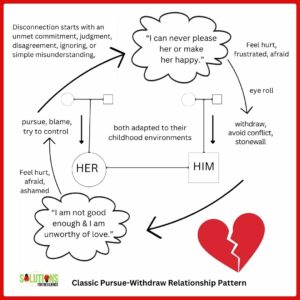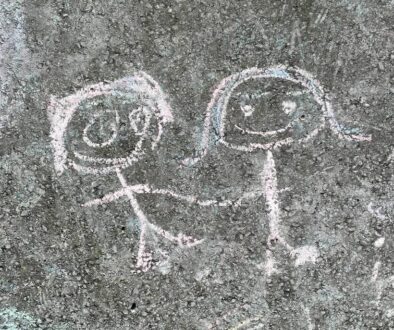Repairing Painful Patterns of Disconnection in Couples
 Most of my clients seek individual therapeutic counseling to address stress, anger management, or intrusive thoughts, often stemming from childhood abuse and neglect, or generational trauma. However, I feel a special honor when couples choose to confront their relationship conflicts, disconnection, or dissatisfaction. Disconnection in couples can be repaired.
Most of my clients seek individual therapeutic counseling to address stress, anger management, or intrusive thoughts, often stemming from childhood abuse and neglect, or generational trauma. However, I feel a special honor when couples choose to confront their relationship conflicts, disconnection, or dissatisfaction. Disconnection in couples can be repaired.
The Pattern of Disconnection in Couples
In every relationship, conflict is inevitable. How couples navigate these moments defines the health and longevity of their partnership. Often, they find themselves trapped in recurring patterns of disconnection—fighting, defending, fleeing, or disappearing.
This dance of miscommunication and misunderstanding can lead to emotional pain and a sense of hopelessness. Yet, with insight, patience, and commitment, couples can break these patterns and move towards deeper understanding, connection, and love.
I feel energized when a couple decides to do the work. My goal is to make the pattern or dance of interaction the enemy, instead of each other. I want them to team up and tackle the real problem, together. We not only identify the couple’s pattern but use the three Cs of intimate relationships—Commitment, Care, and Cherishing behaviors.
My work with couples is informed by marital experts such as: Terry Real, author of Us: Getting Past You and Me to Build a More Loving Relationship, John and Julie Gottman’s research at The Gottman Institute, Esther Perel’s podcast Where Should We Begin?, and Canadian therapist Sue Johnson’s Emotionally Focused Therapy.
Mapping the Disconnection Pattern of Withdraw and Pursue
Let’s start by exploring the classic pattern of disconnection in couples of withdrawing and pursuing. Here are two examples.
Patricia and Les Argue Over Closeness and Distance
I know this pattern well because years ago, it was my husband’s and my conflicted pattern. I would demand and pursue emotional closeness, insisting we talk about our feelings. Les, with his introverted preference, needed time and space before connecting. I recall, one day, running from the house to the garage, chasing him and screaming, “Answer me!”
I felt disconnected, rejected, and ignored, while he felt trapped, invaded, and controlled. The more I pursued, the more he withdrew. The more he withdrew, the more I pursued until both of us were so triggered that we escalated to name-calling. Fortunately, we never reached physical violence. The verbal abuse on one another was hurtful enough.
John and Emily Argue Over Household Chores
John and Emily argue about household chores. Emily feels resentful because she believes John isn’t contributing enough, while John feels criticized.
Emily raises her voice, listing all the things she’s done around the house, and asks John why he doesn’t help more. She follows him from room to room, insisting they talk about it.
John feels attacked and overwhelmed by Emily’s accusations. He becomes silent, avoids eye contact, and eventually retreats to the bedroom, shutting the door behind him. He doesn’t want to escalate the argument, so he withdraws to calm down.
In both examples, the pursuer tries to engage or resolve the issue through increased communication, while the withdrawer retreats, often due to feeling overwhelmed or criticized. This dynamic can create a cycle where the more one partner pursues, the more the other withdraws, leading to further disconnection—unless it is addressed.
Disconnection in Couples Are Often Rooted in Childhood
The withdrawing and pursuing pattern in adult relationships often begins in childhood, particularly in cases of abuse or neglect. Here’s how these early experiences can shape the dance:
- Withdrawal as a Coping Strategy
- A child raised in an emotionally neglectful environment may learn that expressing needs or emotions leads to disappointment or rejection. In adulthood, they might react to perceived rejection or criticism by withdrawing.
- A child raised in an environment of harsh criticism or punishment may learn to suppress their feelings. In adulthood, they might withdraw during conflicts, fearing that expressing emotions will lead to criticism and punishment.
- Pursuing to Gain Security and Attachment
- A child raised by inconsistent caregivers—who sometimes meet their emotional needs and other times are unavailable—may develop an anxious attachment style. They grow up constantly seeking reassurance and connection, fearing abandonment. In adulthood, this can show up as increasingly desperate attempts for attention and validation, especially when they sense disconnection.
- If a child experiences attachment trauma, such as a caregiver being emotionally or physically unavailable during key developmental stages, they may become hypervigilant, always fearing disconnection. This can lead to pursuing behaviors where they try to engage their partner constantly, hoping to prevent a perceived threat of rejection.
- Fear of Abandonment and Fear of Intimacy
- A child who has been abandoned or who has experienced inconsistent caregiving may develop a fear of being left alone. In adulthood, they may pursue their partner excessively, trying to prevent any hint of separation or abandonment.
- Conversely, if a child experiences parental abuse, they might develop a fear of closeness. Intimacy becomes associated with pain and betrayal, leading them to withdraw from their partner when they begin to feel too close or intense. Emotional closeness may trigger memories of past hurt, prompting the person to distance themselves.
- Reenacting Familiar Dynamics
- People often unconsciously recreate patterns from their childhood in adult relationships because the dance is familiar, even if it is painful. They grew up watching their parents engage in a withdraw-pursue pattern they might find themselves falling into the same cycle.
Understanding that these relationship patterns are rooted in early life experiences can be a powerful first step in healing. Effective therapy can help people explore these childhood connections and then more consciously engage with their partner.
In therapy, the individual might:
- Explore childhood experiences and understand how they shape current behaviors.
- Build emotional awareness enabling the safe recognition and expression of emotions, without defaulting to withdrawing or pursuing.
- Practice secure attachment behaviors by developing trust and security in the relationship. Then breaking free from past fear-based patterns.
By addressing the underlying issues rooted in childhood, individuals can move toward healthier, more secure ways of relating in their adult relationships.
Here is a diagram of the classic pursue-withdrawal pattern:

Breaking the Pattern: The Path to Repair
Awareness of childhood triggers and mapping the pattern of disconnection are first steps towards breaking the cycle. Couples are encouraged to get curious about their own individual triggers and reactions. Then they can come together to track their cycle of interaction. Once the pattern is understood it takes discipline and team work to create a brand-new rhythm of interaction. Here are some tips:
- Know the Source of Your Part of the Dance: Depersonalize your reaction from your partner. Acknowledge the role of childhood patterns or generational trauma by saying something like, “I realize when I yelled at you, it was like I was age-7 trying to get the attention of my father.”
- Describe the Circular Pattern: Have a conversation that goes something like, “It seems the more I criticize you the more you withdraw. And the more you withdraw the more I criticize you.” Try to keep your language simple and clear. Imagine a fly on the wall describing the behaviour. Then agree on the circular interaction that gets you disconnected and into conflict.
- Communication: Couples can work on signaling to each other when the pattern or dance begins. Finding a simple name for the pattern is often useful. Dr. Sue Johnson, the developer of Emotionally Focused Therapy (EFT), refers to a couple’a pattern as The Tango. A simple warning or agreed-upon phrase can help couples recognize the pattern early and take a step back to reassess their reactions.
- Be the Hero: Step up in your relationship. Be the one to catch yourself entering the pattern. “Gosh darn! I just criticized you. Enough, eh?”
- Express Emotions: Recognizing and expressing tender emotions without defaulting to blaming, withdrawing, or pursuing is crucial. You might say something like, “Ouch! I feel hurt.”
- Commitment: Both partners need to commit to and invest in the process of repairing and enhancing the relationship. This involves not just recognizing the pattern but actively taking responsibility for fueling the old dysfunctional pattern and contributing to new and healthier interactions.
- Cherishing: Cherishing each other’s efforts and contributions helps rebuild connection. When I acknowledge Les’ emotional availability, and he appreciates my commitment to closeness, we both contribute to a positive marriage where we feel heard and loved.
- Practice Clear Communication: I now let Les know when I want to have a conversation about how I feel, and he agrees. He lets me know how much space and time he needs, and I agree.
- Use Humor and Lightness: Catch times when you step into the pattern. Use it as an opportunity to laugh together and diffuse tension. A playful acknowledgment might sound like, “Oops, here we go!”
- Appreciate the Small Wins: Recognize and celebrate small moments of sharing tender emotions and truly seeking to understand one another.
Conclusion
If these steps to change disconnection in couples seem to require significant focus, discipline and commitment, you are correct. In most cases it requires an informed professional to help couples move forward. No matter, how you get there, please know it is possible. Many couples have found increase marital satisfaction and love by doing the work. As Sue Johnson wisely wrote;
“The best way to create a loving relationship is to cultivate a nurturing environment where love can grow.”
Disconnection in couples can be repaired! When couples make the pattern their enemy rather than each other, and establish new, healthier dances, they create more cherishing, caring, and love.
Please check out these related posts:
- Us: Getting Past You and Me to Build a More Loving Relationship by Terry Real — Book Summary
- Hold Me Tight: Seven Conversations for a Lifetime of Love by Sue Johnson — Book Summary
- The Seven Principles for Making Marriage Work by John Gottman — Book Summary
- Wisely Choose Where You Get Relationship Advice
- Coupleship on the Rocks? How to Decide to Stay or Leave




